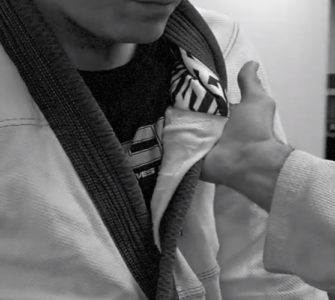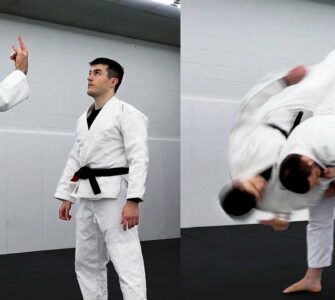Guest post by Evolve MMA, Asia’s premier championship brand for martial arts. It has the most number of World Champions on the planet. Named as the #1 ranked martial arts organization in Asia by CNN, Yahoo! Sports, FOX Sports, Evolve MMA is the top rated BJJ gym in Singapore.
Brazilian Jiu-Jitsu is characterized by its focus on using the guard position. The guard is where you use your body as a shield to control your opponent’s movement and posture. From the guard, you can use a number of techniques to off-balance, sweep and submit an opponent. In this article, we’ll talk about the 10 types of BJJ guards every grappler should know.
1) Closed Guard
The closed guard (also known as the full guard) is the quintessential guard of Brazilian Jiu-Jitsu. It is characterized by using your legs as a noose to lock your opponent in place. Since the closed guard is designed to limit an opponent’s movement, you can typically use posture breaks to further restrict movement and attack the limbs or head.
The closed guard is highly effective in both submission grappling and mixed martial arts. Many legendary fighters have used the closed guard to great effect. This includes many members of the Gracie family, notably Royce and Roger Gracie. Royce was a key figure in the early days of MMA, and his closed guard became the stuff of legends in the early days of the sport. Roger Gracie is a multiple-time BJJ world champion and is widely considered to have the best closed guard in all of grappling.
2) Half Guard
The half guard is where you trap an opponent’s leg using your own and use angles to unbalance an opponent. The half guard is very useful because it is a guard that can be as dynamic or static as you want it to be; there are many variants of the half guard (Z guard, deep half, knee shield, lockdown, etc.), and it’s up to the practitioner to decide on what to use based on his or her game. This guard was initially used as a last-ditch effort before your guard gets passed. Over the years, many specialists have used the half guard as their primary guard in competition.
3) Butterfly Guard
The butterfly guard is where you use your shins to block the opponent from the front. This is an excellent guard to use if you prefer an attacking game. This guard was popularized by multiple-time world champion Marcelo Garcia. Adding this guard to your game is an absolute must if you want a strong open guard.
4) Collar And Sleeve Guard
The collar and sleeve guard is a gi-specific technique where you control your opponent’s upper body and arm by using a cross grip on the collar and gripping one of the sleeves. This is a fundamental guard and has a lot of overlap with the closed guard. The collar and sleeve guard is perhaps the best guard to teach beginners because it focuses on using controlling concepts to disrupt an opponent’s posture.
5) Spider Guard
The spider guard is a gi-specific technique where you use your legs to control the opponent’s upper body. You use your feet as a blocking mechanism by placing them towards your opponent’s biceps while you hold the sleeve with your hands. This is a very controlling guard and is the perfect guard to use for those who love to use triangle chokes and omoplatas.
6) De La Riva Guard
The De La Riva guard is where you loop one of your legs on an opponent’s leg and use your other leg to block the opposite hip. You then control the upper body by either gripping a sleeve or the collar. This is a classic guard popularized by BJJ legend Ricardo De La Riva. It has seen a resurgence in the last few decades due to the berimbolo – an attack from the De La Riva guard where you spin underneath to either take the back or establish a pin.
7) Reverse De La Riva Guard
The reverse De La Riva guard is similar to the regular De La Riva guard, except you loop your leg from the inside position. This is a great guard to use against standing passers because it restricts many splitting guard passes from the standing position. The reverse De La Riva is a great guard to use for both gi and no-gi BJJ.
8) X-Guard
The x-guard is an open guard where your legs form an “x” position underneath your opponent. The general premise of this guard is to disrupt the opponent’s balance either by expanding or contracting your leg configuration. There is a similar variant of the x-guard called the reverse x-guard. It acts similar to the regular x, but the leg position of the “x” is in reverse. The reverse x-guard is a great position to use if you like leg locks.
9) Single Leg X-Guard
The single leg x-guard (SLX) is similar to the regular x-guard, but you isolate one side of the hip instead of two. This is a very common guard in modern no-gi BJJ because it opens up many attacking options, most notably leg locks. Popular users of the SLX include Garry Tonon and Gordon Ryan.
10) Lapel Guards
Lapel guard is a blanket term used for any guard that uses the lapel to control an opponent. A popular example of a lapel guard is the worm guard, a technique used by BJJ superstar Keenan Cornelius.
Wrapping your far foot around the opponent’s leg is the primary objective of this technique. Looping the gi between your and their leg while hanging on to the gi’s bottom fabric (tail) accomplishes this. The configuration of this guard establishes a strong connection between the two BJJ players, allowing for a variety of sweeps and submissions.
Conclusion
These are some of the best guards in the sport of Brazilian Jiu-Jitsu. Take note that BJJ is still evolving as we speak. This means that we may hear new variants of the guard in the years to come. If you are new to the sport, we suggest studying the closed, half, and collar and sleeve guards first. Get comfortable with these and work on the standard entries, attacks, and defenses of these positions. Feel free to explore other guards as you progress in your BJJ journey.
















